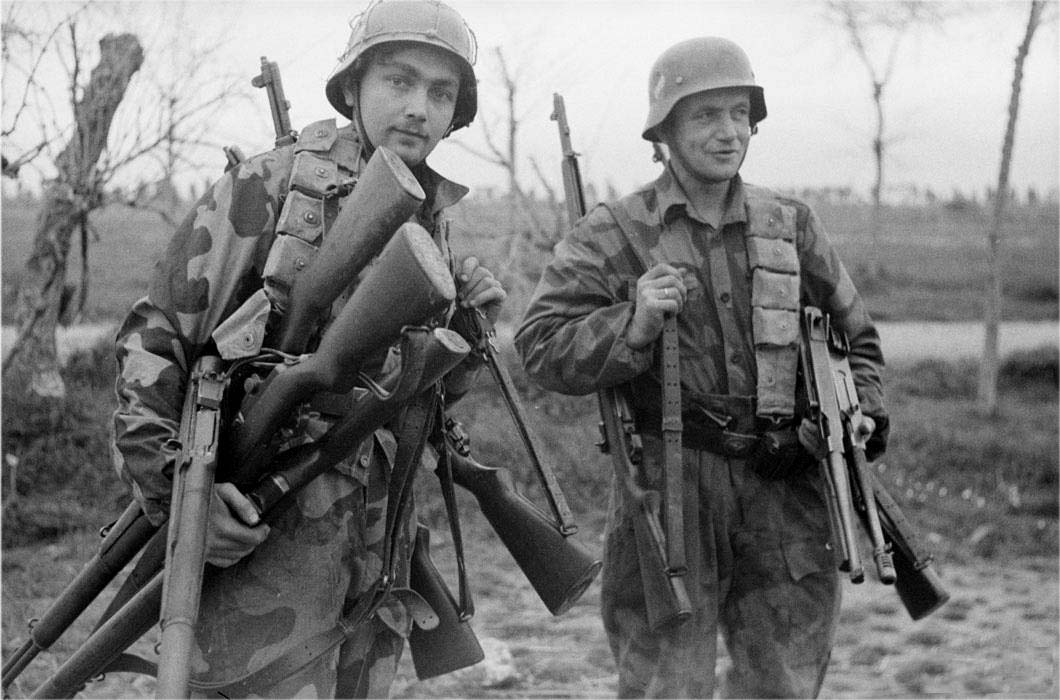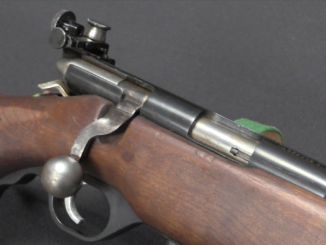One of the early combination self-defense guns was the “Sure Defender”, with a combination of brass knuckles, a small and finicky wavy-bladed dagger, and a single shot percussion pistol barrel. The rather complex process for making the knife or pistol components ready to actually use suggest that this may not have been the most practical tool…but the tacti-cool has always been popular, whether in the 1860s or in the present day.
Related Articles

Semiauto Rifles
Vintage Saturday: More Spoils
German soldiers with captured American small arms, circa 1944. The other guy’s stuff is always better than yours, right? Well, I would rather have an M1 than a K98k, but the Thompsons? No thanks. Interesting […]

Bolt Action Rifles
Mossberg 44US: A Cheaper Training Rifle for World War Two
As World War Two expanded to encompass the whole US economy, it became clear to the Army that some cost cutting measures would be required. One place that was a clear choice was in rimfire […]

Prototype
Savage Prototype .25ACP (Video)
So, this is a video I took over a year ago, and then lost track of – a prototype .25ACP Savage pistol. It is plain blowback, not using the rotating-barrel mechanism of the mainstream .32 […]

“Master of none” You’d be better off to have separate nucks, a dagger and derringer, but that wouldn’t be kewl
Since watching the Reid “My Friend” episode(s), I’ve always thought something like that (which has a ring for your second finger) plus a conventional trigger guard would make sense. It would provide you two brass knuckles, the barrel, and a dagger blade (if desired) all oriented in the same direction, ready for use, rather than “either / or”.
My first thought with this one is “for a more civilized age” – not because it’s necessarily “an elegant weapon”, but because only the most courteous adversary would give you time to either unfold the dagger or cap the nipple!
In Germany, there was a time when vest-pocket pistols, and many other mechanical contraptions (percussion lighters, salt mills, tiny binoculars, watches) were very popular, and were not only carried fore their use, but also as status symbol, conversation piece etc – maybe a bit like smartphones and smart watches etc. in our time.
Somehow I feel this knuckledaggergun falls into this category.
Okay, here we go with more click-bait. Given a choice, which would you take into a dark alley shuffle?
1. Impractical knuckleduster/pocket-knife gun
2. Colt Detective Special
3. Mossberg 590A1 Retrograde with bayonet
4. Walther PPK
5. Beretta 92X Compact (aw, heck, I’ll give you TWO of them)
6. Lupara
7. baseball bat
8. M1921 Thompson
9. Cutlass
10. Get something else!
“(…)10. Get something else!(…)”
For usage in dark and possibly vintage?
Then take this Italian flintpistol-lantern http://historypistols.ru/blog/kremnevye-pistolety/italyanskij-pistolet-fonar/
It seems to me that the pinfire version would be prone to malfunctions due to the design and fragility of the priming pin, and that a simplified single shot mechanism would be preferable with rimfire or centerfire cartridges or a double barrel percussion setup. I would also vote for a separate more useful knife. Interesting attempt to solve an ongoing dilemna of personal defense in an ever more dangerous world.
A switch blade type knife would make a lot of sense .. as well as a double barrel center/rim fire pistol ..
In the past this type of weapon was known, or referred to, as an Apache pistol, after the Parisian gangs with which it was (supposedly?)associated.
Should it be viewed as an easily-concealable multi-weapon for gangsters, rather than a self-defence tool for their intended prey?
https://en.wikipedia.org/wiki/Apaches_(subculture)
https://www.youtube.com/watch?v=-rX_SHIZaRI&t=77s
The task of “killing the attacker” is not always the case.
Most decompensated individuals, which are usually street drug addicts and other scum, usually only need to see the confident behavior of a potential “victim” (especially in combination with an incomprehensible mechanical device in hand) to crap and run away.
Great plot and very nice device.
PS Of course, if the attacker has something in his hands, you should immediately shoot.
It looks like a simpler version of the Dolne “Apache” piitol, single-shot instead of pepperbox-type revolver.
Considering that SOE actually prototyped a Dolne-type stamped- steel revolver in 9 x 19mm during WW2, I’m surprised something like this didn’t show up in their armory as well.
It might have been somewhat more useful than the OSS McLaglen Peskett close-combat weapon;
https://en.topwar.ru/150872-mnogofunkcionalnoe-oruzhie-mclaglen-peskett-close-combat-weapon-ssha.html
Which had little utility other than instantly identifying the owner to the Gestapo and Milice as someone who needed to be first interrogated, and then shot.
cheers
eon
This harvester is not for a “plainclothes agent”.
This is for “normal” partisans.
In this connection, one recalls the memoirs of some of the resistance fighters.
They had a serious technical difficulty, when it was necessary to carry out the sentence to the traitor, but it was impossible to shoot, and no one had a knife.
The curtain cord became the instrument of retaliation. And the executioner, chosen by lot, earned a serious psychological trauma.